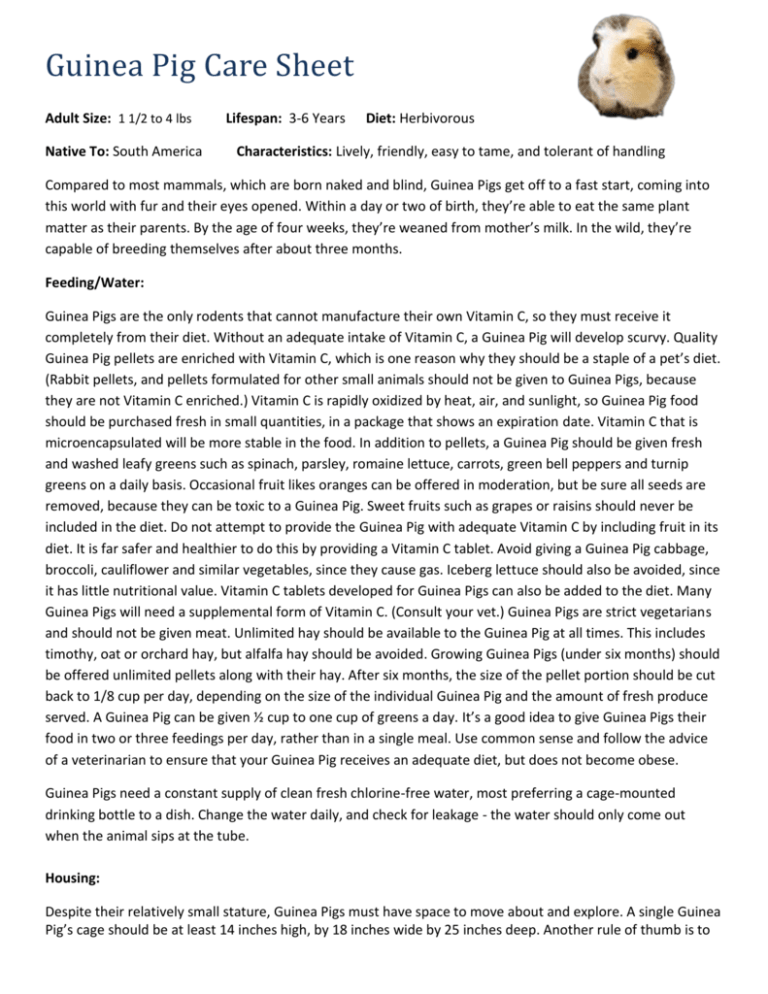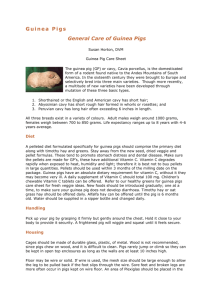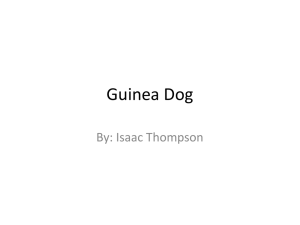File - Critters Exotic Pets
advertisement

Guinea Pig Care Sheet Adult Size: 1 1/2 to 4 lbs Native To: South America Lifespan: 3-6 Years Diet: Herbivorous Characteristics: Lively, friendly, easy to tame, and tolerant of handling Compared to most mammals, which are born naked and blind, Guinea Pigs get off to a fast start, coming into this world with fur and their eyes opened. Within a day or two of birth, they’re able to eat the same plant matter as their parents. By the age of four weeks, they’re weaned from mother’s milk. In the wild, they’re capable of breeding themselves after about three months. Feeding/Water: Guinea Pigs are the only rodents that cannot manufacture their own Vitamin C, so they must receive it completely from their diet. Without an adequate intake of Vitamin C, a Guinea Pig will develop scurvy. Quality Guinea Pig pellets are enriched with Vitamin C, which is one reason why they should be a staple of a pet’s diet. (Rabbit pellets, and pellets formulated for other small animals should not be given to Guinea Pigs, because they are not Vitamin C enriched.) Vitamin C is rapidly oxidized by heat, air, and sunlight, so Guinea Pig food should be purchased fresh in small quantities, in a package that shows an expiration date. Vitamin C that is microencapsulated will be more stable in the food. In addition to pellets, a Guinea Pig should be given fresh and washed leafy greens such as spinach, parsley, romaine lettuce, carrots, green bell peppers and turnip greens on a daily basis. Occasional fruit likes oranges can be offered in moderation, but be sure all seeds are removed, because they can be toxic to a Guinea Pig. Sweet fruits such as grapes or raisins should never be included in the diet. Do not attempt to provide the Guinea Pig with adequate Vitamin C by including fruit in its diet. It is far safer and healthier to do this by providing a Vitamin C tablet. Avoid giving a Guinea Pig cabbage, broccoli, cauliflower and similar vegetables, since they cause gas. Iceberg lettuce should also be avoided, since it has little nutritional value. Vitamin C tablets developed for Guinea Pigs can also be added to the diet. Many Guinea Pigs will need a supplemental form of Vitamin C. (Consult your vet.) Guinea Pigs are strict vegetarians and should not be given meat. Unlimited hay should be available to the Guinea Pig at all times. This includes timothy, oat or orchard hay, but alfalfa hay should be avoided. Growing Guinea Pigs (under six months) should be offered unlimited pellets along with their hay. After six months, the size of the pellet portion should be cut back to 1/8 cup per day, depending on the size of the individual Guinea Pig and the amount of fresh produce served. A Guinea Pig can be given ½ cup to one cup of greens a day. It’s a good idea to give Guinea Pigs their food in two or three feedings per day, rather than in a single meal. Use common sense and follow the advice of a veterinarian to ensure that your Guinea Pig receives an adequate diet, but does not become obese. Guinea Pigs need a constant supply of clean fresh chlorine-free water, most preferring a cage-mounted drinking bottle to a dish. Change the water daily, and check for leakage - the water should only come out when the animal sips at the tube. Housing: Despite their relatively small stature, Guinea Pigs must have space to move about and explore. A single Guinea Pig’s cage should be at least 14 inches high, by 18 inches wide by 25 inches deep. Another rule of thumb is to provide at least 1 square foot of added floor space for each additional Guinea Pig in an enclosure. (As noted above, Guinea Pigs are happiest when housed in same-sex pairs, but will also do well alone, if given attention by their human companions.) The cage must be large enough to contain a secluded hide-away, which is essential for a Guinea Pig’s psychological health, as well as a food bowl and toys. Cages that open from the top are preferable, since they make it easier to pick up the Guinea Pig safely and are less difficult to clean. A Guinea Pig’s enclosure must be well ventilated. Aquarium tanks must not be used to house Guinea Pigs, because they do not provide adequate ventilation. Poor air circulation promotes infectious diseases and respiratory ailments. Avoid wire mesh floors, since they can cause foot and leg sores. Slatted plastic floors are acceptable, but solid floors are better. Commercially available Guinea Pig cages comprise a plastic tub base with a detachable wire top. Never locate a Guinea Pig’s cage in direct sunlight or drafty areas, including attics and basements. The cage should be place in a quiet area that has a consistent temperature and is not accessible to other pets. Bedding: Guinea Pigs need around an inch of an absorbent substrate – recommended materials includes as aspen shavings or a pelleted rodent bedding on the floor of their enclosure. Fine sawdust can create too much dust in the enclosure, leading to eye irritations and respiratory infections. Cedar and pine based products should never be used, since they can cause severe respiratory problems. Hay is essential for a Guinea Pig’s health and well-being. Guinea Pigs enjoy burrowing in hay, plus chewing on hay will help wear down their constantly growing teeth. Timothy, oat or orchard hay is preferable to alfalfa hay, which has a high fat content. Alfalfa hay can be offered during early growth periods and to pregnant females. Straw should never be used in a Guinea Pig enclosure, because its sharp points can injure the animal’s eyes. Since hay does not control odors and turns moldy very quickly when it gets wet or soiled, it should be changed every day or two. The absorbent wood shavings beneath the hay need to be changed once a week. If you use corn cob bedding change it often to protect against the buildup of bacteria and mold. Also do not use corn cob bedding with a pet that may ingest bedding. Exercise & Chewing: Guinea Pigs will be healthier, happier and more alert if they’re given the chance to get outside their cage every day for some play and exercise. Letting the Guinea Pig run free in a room of the house under the constant supervision of its human companion is fine, provided the room is pocket pet-proof. This means that doors and windows are secure, so there is no way for the Guinea Pig to get out or another pet to get in; that the space below or behind heavy furniture is blocked off; and that electrical cords and potentially toxic household plants and cleaners are not accessible. An alternative is to place temporary playpen gating in the room. The pen should be at least 20” high to prevent escapes. Most Guinea Pigs will welcome the opportunity to explore the inside of a paper bag or box when let outside the cage. For fun, place a plastic child’s wading pool in a room and fill it with timothy hay, then watch as the Guinea Pigs have the time of their lives burrowing. Inside the cage, a Guinea Pig must have constant access to chew blocks, gnawing logs or any other toy that it can chomp on safely. A Guinea Pig’s teeth are constantly growing, and must be trimmed by chewing the right foods and chew toys. Platforms that afford climbing opportunities are always appreciated by Guinea Pigs as are tunnels that they can crawl through. Make sure that tunnels are wide enough for the pet to enjoy without getting stuck. Large fleece logs and blankets can also be provided to the Guinea Pig. All toys and accessories must be inspected for soiling or damage caused by chewing. Soiled or damaged items should be removed from the cage and either cleaned or discarded. Guinea Pigs should not be given exercise wheels, since this can harm them. Although Guinea Pigs should not be kept outdoors, they will enjoy spending time in a secure escapeproof backyard pet pen under the close and constant supervision of their human companion. Never leave the Guinea Pig alone outdoors – it can soon dig its way out, or be attacked by a passing cat. If a Guinea Pig’s pen is placed outdoors for even a brief play period, make sure that the grass below it has not been treated by pesticides or other chemical agents. Grooming: Shorthaired Guinea Pigs need brushing only once a week, with a fine-tooth comb or a pin brush. Any rosettes should be brushed in the natural direction of hair growth. Longhaired Guinea Pigs need thorough grooming every day with a widetooth comb and a slicker brush. When the hair is thoroughly detangled, the hair is often set in special balsa wood or cotton wraps to keep it clean and tidy. If the hair is left unwrapped, the animal will trip over it, drag it through soiled substrate and may accidentally urinate on it. All Guinea Pigs need their nails trimmed every 8 to 12 weeks. Since the nail has a blood supply known as the ‘quick’ that can easily be nicked, this task is best left to a veterinarian at first. After observing the correct way to trim the nails, some owners choose to trim their pet’s nails at home, one person holding the animal wrapped in a towel while a second person trims the nails. Lighting: Hamsters have no special lighting requirements, other than a 12-hour on/12-hour off day/night cycle. Temperature & Humidity: No Special Needs: Guinea Pigs have no special heating or lighting requirements, and are generally happy at an average room temperature. A temperature in the 65-70 degree Fahrenheit range and a humidity of 50 percent are ideal. How to Handle: As applies to their gentle nature, Guinea Pigs are delicate animals with fragile bones. They can easily become injured if dropped or mishandled. Approach a Guinea Pig gently with two hands. Place one hand gently but securely under the chest, restraining one front leg by placing a finger in front of it. Use your other hand to support the Guinea Pig’s hindquarters. Cradling the pet, pull him closer to your body so he feels safer. Never pick a Guinea Pig up by the shoulders or front of his body, since this can cause injury. Some Guinea Pigs have a tendency to jump out of their human companion’s hands when being set down. To reduce the risk of this behavior and the injuries it can cause, lower a Guinea Pig back into its enclosure rump first, rather than holding the animal parallel to the ground. The material is a general guideline, and is not intended to serve as your sole sources of pet care information. Visit a veterinarian and consult a broad range of literature to ensure that your pet receives adequate care. Recommended Supplies: Enclosure Vitamin C Enriched Guinea Pig Food Pellets Vitamin C Supplement Chew Block Absorbent, Dust-Free Bedding Timothy Hay Metal Tipped Water Bottle Food Bowl






